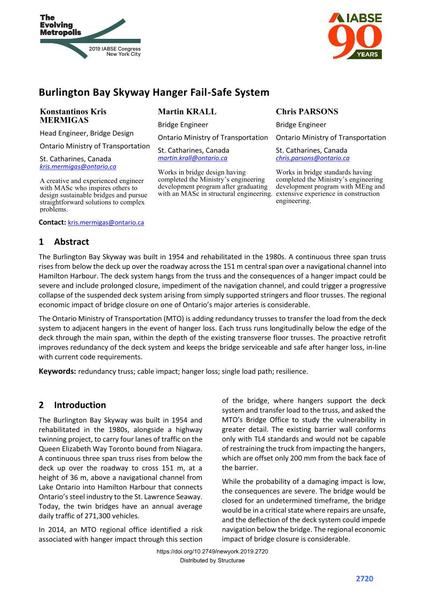Burlington Bay Skyway Hanger Fail-Safe System

|
|
|||||||||||
Bibliografische Angaben
| Autor(en): |
Konstantinos Kris Mermigas
Martin Krall (Ontario Ministry of Transportation) Chris Parsons (Ontario Ministry of Transportation) |
||||
|---|---|---|---|---|---|
| Medium: | Tagungsbeitrag | ||||
| Sprache(n): | Englisch | ||||
| Tagung: | IABSE Congress: The Evolving Metropolis, New York, NY, USA, 4-6 September 2019 | ||||
| Veröffentlicht in: | The Evolving Metropolis | ||||
|
|||||
| Seite(n): | 2720-2725 | ||||
| Anzahl der Seiten (im PDF): | 6 | ||||
| DOI: | 10.2749/newyork.2019.2720 | ||||
| Abstrakt: |
The Burlington Bay Skyway was built in 1954 and rehabilitated in the 1980s. A continuous three span truss rises from below the deck up over the roadway across the 151 m central span over a navigational channel into Hamilton Harbour. The deck system hangs from the truss and the consequences of a hanger impact could be severe and include prolonged closure, impediment of the navigation channel, and could trigger a progressive collapse of the suspended deck system arising from simply supported stringers and floor trusses. The regional economic impact of bridge closure on one of Ontario’s major arteries is considerable. The Ontario Ministry of Transportation (MTO) is adding redundancy trusses to transfer the load from the deck system to adjacent hangers in the event of hanger loss. Each truss runs longitudinally below the edge of the deck through the main span, within the depth of the existing transverse floor trusses. The proactive retrofit improves redundancy of the deck system and keeps the bridge serviceable and safe after hanger loss, in-line with current code requirements. |
||||
